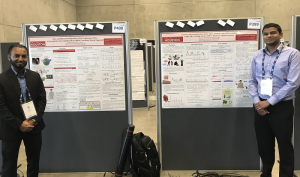Featured UH Research Marries Health Care and Engineering
Rose Faghih, assistant professor, and several other UH Cullen College of Engineering faculty and students were an integral part of the 2019 IEEE Engineering in Medicine and Biology Conference held in Berlin, Germany. The theme was “Biomedical engineering ranging from wellness to intensive care.”
The IEEE EMBC, the premier global conference in biomedical engineering, brings together industry and academic leaders as well as students who are interested in the role of engineering in medicine and biology.
“Although my training has all been in electrical engineering, I chose to perform research and apply my knowledge in the medical field to contribute to improving people's lives,” Faghih said. “Every time I attend EMBC, I learn about different fascinating research in biomedical engineering around the globe. This is very inspiring and helps me shape new ideas and new research directions with the goal of making significant contributions to health care.”
Faghih and Sabato Santaniello, assistant professor of biomedical engineering at the University of Connecticut, co-organized and co-chaired an invited session titled “Understanding the Link between Brain Dynamics and Behavior.” It featured three Cullen College speakers – Jose Luis Contreras-Vidal, Joe Francis and Faghih – in addition to speakers from the UConn, Johns Hopkins University and University of Liège.
“We had over 80 attendants in our invited session and received exciting feedback from colleagues in the audience,” Faghih said.
Faghih was also a featured leader at the “Lunch With Leaders,” an event for students and young professionals at EMBC. In this role, she shared insights and advice about academia and career development.
Three Cullen College electrical engineering students, members of the UH Computational Medicine Lab (CML), also attended the conference.
CML, led by Faghih, conducts research in the fields of biomedical and neural engineering with a particular emphasis on the design of different algorithms for the analysis of physiological signals. A major focus of the lab is to view the human body as a complex system whose disorders can be treated from a control-theoretic point of view.
The students are:
Dilranjan Wickramasuriya and Md. Rafiul Amin, both pursuing Ph.D.; as well as Divesh Pednekar, a master’s student. Of these, Wickramsuriya and Amin each won a Cullen Graduate Fellowship Travel Grant – a competitive fellowship program that allows graduate students to showcase their research and scholarly work at conferences, meetings and exhibits – to attend EMBC in Berlin.
Lab members presented six papers (five regular and one invited) at the 2019 EMBC. Here’s a list and short descriptions of the CML papers based on research funded in part by the National Science Foundation (click on the links to read the complete papers):
Dilranjan Wickramasuriya, Rose T. Faghih, "A Cortisol-Based Energy Decoder for Investigation of Fatigue in Hypercortisolism." (regular paper)
Hormones play a crucial role in governing the body’s internal environment. Cortisol, considered to be the body’s main stress hormone, is one such example. Its primary task is to raise blood glucose levels in order to give the body more energy in response to external stressors. Disorders in cortisol secretion typically involve either too much or too little cortisol being secreted into the bloodstream.
Researchers at CML developed a method to extract an unobserved energy-state from the body based on simulated cortisol measurements. The method used the secretion timings of cortisol, and the upper and lower cortisol levels throughout the day to estimate energy. Data were simulated for a healthy subject and patients with Cushing’s disease (a disorder with excess cortisol secretion) for estimating energy. The results showed almost random energy fluctuations throughout the day for the Cushing’s patients, and provided insight into why these patients may experience daytime fatigue and nighttime sleep disturbances.
Md. Rafiul Amin, Dilranjan Wickramasuriya, Rose T. Faghih, "Wearable-Machine Interface Architectures for Mental Stress." (invited session)
Mental stress causes variations to occur in the conductivity of the skin. These variations are caused by changes in the rate at which electrical impulses are sent to the nerves in the sweat glands. CML researchers developed a method to detect these electrical impulses to the sweat glands, and a second method to estimate stress from the rate at which they occur. Promising results were obtained on a publicly available dataset that examined the effect of different types of stress on various physiological signals. High stress was detected during cognitive tasks while low levels were detected during periods of relaxation.
Dilranjan Wickramasuriya, Rose T. Faghih, "A Novel Filter for Tracking Real-World Cognitive Stress Using Multi-Time-Scale Point Process Observations." (regular paper)
Stress has been dubbed the “health epidemic of the 21st century” by the World Health Organization, and the workplace is one of the most stressful places for many people. In this work, CML researchers developed a method to estimate stress from skin conductance and electrocardiography (EKG) measurements.
The conductivity of the skin changes due to sweating. Sweat secretions primarily help maintain body temperature. However, tiny bursts of sweat are also released in response to psychologically arousing stimuli. The higher the arousal, the higher the rate at which these bursts of sweat are released. Heart rate speeds up with high levels of arousal as well. Both skin conductance and EKG can be converted to a series of binary observations (ones and zeroes) – skin conductance by identifying the locations of the bursts of sweat, and EKG by identifying the locations of the heartbeats.
By tracking the rates at which ones and zeroes occur in both sequences of binary data, it is possible to estimate a person’s stress level. The results obtained by the researchers revealed that unfamiliarity with a task is one of the main causes of stress rather than distracting interruptions or time constraints.
Md. Rafiul Amin, Rose T. Faghih, "Tonic and Phasic Decomposition of Skin Conductance Data: A Generalized-CrossValidation-Based Block Coordinate Descent Approach." (regular paper)
Variations in sweat secretions cause the conductivity of the skin to change. These changes in conductivity can easily be measured using electrodes placed on locations such as the palms or wrists.
A skin conductance signal comprises of two parts - a slow-varying baseline level known as the tonic component and a faster varying phasic component. The phasic component reflects changes in sweat secretions occurring as a result of psychological arousal. This is partly due to the fact that sweat glands are innervated by nerves from the sympathetic branch of the nervous system the branch that governs the body’s “fight or flight” mechanism. Therefore, separating the phasic and tonic components in skin conductance signals is an important first step in automatically inferring emotions such as fear and stress from physiological data, Faghih said.
In this work, CML researchers developed an efficient algorithm to separate skin conductance into its constituent phasic and tonic parts.
Hamid Fekri Azgomi, Dilranjan Wickramasuriya, Rose T. Faghih, "State-Space Modeling and Fuzzy Feedback Control of Cognitive Stress." (regular paper)
While many techniques exist for relieving stress, CML researchers sought to answer the question, “Is it possible to regulate stress by treating the brain and different physiological signal responses within a mathematical system-model framework?”
They developed a mathematical framework relating the brain’s stress state to the rate at which tiny bursts of sweat are released by the skin. Promising preliminary results were obtained with simulated data both for decreasing stress and increasing stress. Future work in this area will involve exploring a realistic means of actuation such as music, light, etc.
Divesh Deepak Pednekar, Md. Rafiul Amin, Hamid Fekri Azgomi, Kirstin Aschbacher, Leslie J. Crofford, Rose T. Faghih, "A System Theoretic Investigation of Cortisol Dysregulation in Fibromyalgia Patients with Chronic Fatigue." (regular paper)
Fibromyalgia syndrome (FMS) affects approximately 150 million people worldwide. While the exact causes of FMS are currently not fully known, it is characterized using symptom-related guidelines such as pain, fatigue, morning stiffness and a lack of sleep. This is inefficient as patients with chronic fatigue syndrome (a similar medical condition) also exhibit similar symptoms.
In this work, CML researchers examined patterns in cortisol secretion in an attempt to characterize FMS. Results demonstrated a difference in cortisol secretion in FMS patients compared to healthy subjects. It is likely that these differences partly arise due to the inability of FMS patients to clear cortisol from their blood at the same rate that healthy subjects do, Faghih said.
“Our lab has been very productive and as a result we had a great showing at the conference,” she added. “Colleagues from around the world were excited about our research and interested in collaborating with us.”

